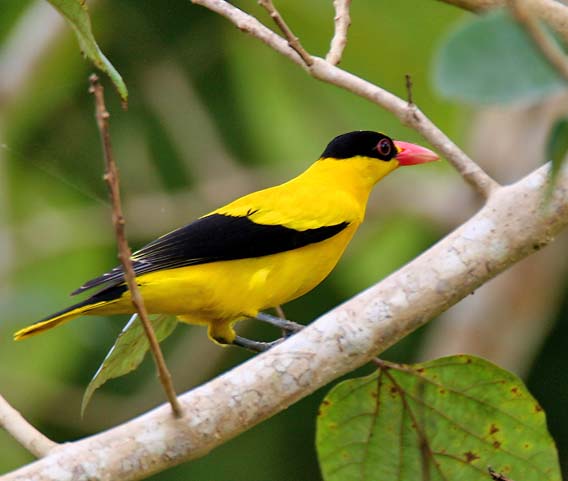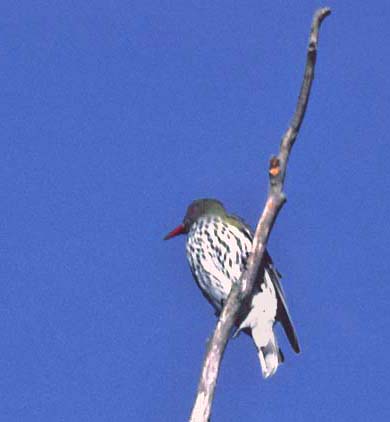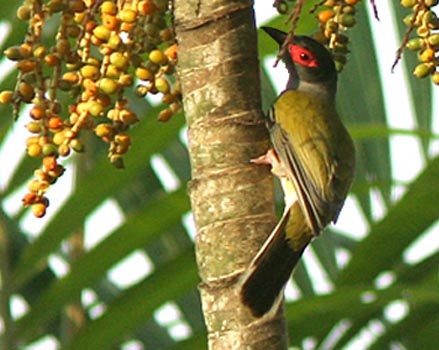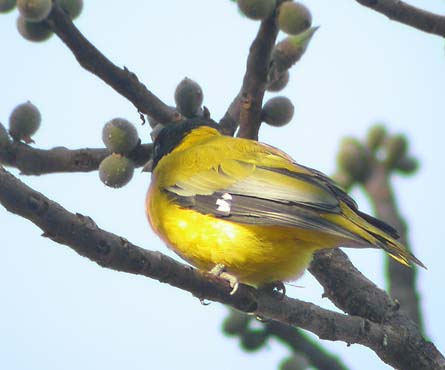| |
OLD WORLD ORIOLES Oriolidae
Old World orioles, figbirds, and true pitohuis |
- 32 species in the Old World
- DR personal total: 18 species (56%), 2 photo'd
|
 The
Oriolidae are a small family of highly arboreal, medium-sized birds
inhabiting woodlands, forest, and parklands of the warmer parts of the
Old World. Until very recent molecular evidence showed that two
Pitohuis were closely related (Dumbacher et al. 2008, Jønsson et
al. 2008), the family was composed simply of the Old World orioles and
figbirds (Walther & Jones 2008). But the addition of the two
pitohuis(see below) does not change the overall structure of this
family, as the two "true pitohuis" are, also, mid-sized, colorful,
arboreal species. The
Oriolidae are a small family of highly arboreal, medium-sized birds
inhabiting woodlands, forest, and parklands of the warmer parts of the
Old World. Until very recent molecular evidence showed that two
Pitohuis were closely related (Dumbacher et al. 2008, Jønsson et
al. 2008), the family was composed simply of the Old World orioles and
figbirds (Walther & Jones 2008). But the addition of the two
pitohuis(see below) does not change the overall structure of this
family, as the two "true pitohuis" are, also, mid-sized, colorful,
arboreal species.
Old World orioles — 27 species in genus Oriolidae — comprise the bulk of the family. Many of these are brightly-patterned in striking colors, like Black-naped Oriole
(left © Blake Matheson), a widespread species of southeast Asia.
It is among the migratory species of Old World oriole, with some
populations breeding from China and Korea but wintering to India and
the Malay Peninsula. Other populations are resident in the Philippines
and Greater Sundas. |
 Not all of the Old World orioles are dramatically patterned. Olive-backed Oriole
of northern and eastern Australia and southern New Guinea (right) is
much less colorful than some species. It does have the bright oriole
bill. Like most orioles it is omnivorous, feeding heavily on fruits,
berries, and nectar in season, but also taking a wide variety of
arthropod prey, and has been known to eat nestlings of other birds.
Because it does depend to some degree on seasonal food, it can be
nomadic within its range. It breeds throughout the year and may have
two broods in good years. Not all of the Old World orioles are dramatically patterned. Olive-backed Oriole
of northern and eastern Australia and southern New Guinea (right) is
much less colorful than some species. It does have the bright oriole
bill. Like most orioles it is omnivorous, feeding heavily on fruits,
berries, and nectar in season, but also taking a wide variety of
arthropod prey, and has been known to eat nestlings of other birds.
Because it does depend to some degree on seasonal food, it can be
nomadic within its range. It breeds throughout the year and may have
two broods in good years.
You may note that I use the term "Old World orioles" for the Oriolidae, while texts published in the Old World, like the Handbook of the Birds of the World
series (Walther & Jones 2008) call them simply "Orioles." From an
American perspective, we have a common set of colorful, arboreal,
woodland birds that we call orioles. These, which are in the genus Icterus and include the well-known Baltimore Oriole I. galbula
(for whom the professional baseball team, the Baltimore Orioles, are
named), are entirely unrelated to the Oriolidae. The New World orioles
are members of the Icteridae, and closely
related to New World blackbirds, cowbirds, oropendolas, meadowlarks,
and allies. So when talking to New World audiences, we have to clearly
explain that New World orioles are icterids, and found well apart from
the Old World orioles (Oriolidae) in any phylogenetic list of passerine
birds. |
 The Oriolidae includes three species of figbirds in the genus Sphecotheres. The widespread one is Green Figbird
(left © Simon Woolley) of eastern and northern Australia and
southeastern New Guinea. The other figbirds are endemics to Timor and
Wetar (S. viridis and S. hypoleucus, respectively). Figbirds do focus heavily on fruit, and have bare skin around the eyes. The Oriolidae includes three species of figbirds in the genus Sphecotheres. The widespread one is Green Figbird
(left © Simon Woolley) of eastern and northern Australia and
southeastern New Guinea. The other figbirds are endemics to Timor and
Wetar (S. viridis and S. hypoleucus, respectively). Figbirds do focus heavily on fruit, and have bare skin around the eyes. |
 There are migratory orioles in Europe (e.g., Eurasian Golden Oriole Oriolus oriolus) but many Old World orioles are resident in Old World tropics. One of these is Abyssinian Black-headed Oriole
(right © Mark Harper), which is restricted to highland forests in
Ethiopia and Eritrea. Africa has a set of isolated montane orioles, and
even island endemic (e.g., Sao Tome Oriole O. crassirostris) as well as widespread lowland species. Likewise, in southeast Asia, there are isolated montane oriole (e.g., Black Oriole O. hosii, a very difficult endemic of northern Borneo) and island specialists (e.g., Gray-collared Oriole O. forsteni of Seram), as well as more widespread and common species. Some of the localized endemics are endangered. There are migratory orioles in Europe (e.g., Eurasian Golden Oriole Oriolus oriolus) but many Old World orioles are resident in Old World tropics. One of these is Abyssinian Black-headed Oriole
(right © Mark Harper), which is restricted to highland forests in
Ethiopia and Eritrea. Africa has a set of isolated montane orioles, and
even island endemic (e.g., Sao Tome Oriole O. crassirostris) as well as widespread lowland species. Likewise, in southeast Asia, there are isolated montane oriole (e.g., Black Oriole O. hosii, a very difficult endemic of northern Borneo) and island specialists (e.g., Gray-collared Oriole O. forsteni of Seram), as well as more widespread and common species. Some of the localized endemics are endangered.
An
exciting discovery of the past decade was that some birds were toxic. A
powerful neurotoxin, chemically similar to that found in Central
American poison dart frogs, is present and has long been known to
native peoples in New Guinea, who avoid eating pitohuis. The toxin is
most potent in two Pitohuis — Variable Pitohui P. kirhocephalus and Hooded Pitohui P. dichrous — of New Guinea. In studying the evolution of these toxins, Dumbacher et al. (2008) found that the genus Pitohui was paraphyletic, with its members belonging to four different avian families! |
 The Hooded Pitohui
(left © Mark Harper) and Variable Pitohui proved to be close
relatives of Old World Orioles. This was confirmed by Jønsson et
al. (2008), who presented evidenced that the presence of neurotoxic
alkaloids has evolved several times in New Guinea birds, and it may
even be widespread in corvoid birds. The toxins come from eating
poisonous melyrid beetles (Choresine), and the toxins are stored in the
skin and feathers. They have been detected in Black "Pitohui" and in
Rusty "Pitohui," which are not true pitohuis but are Whistlers; in Rufous Shrike-Thrush Colluricincla megarhyncha of New Guinea; and in Blue-capped Ifriti Ifrita kowaldi, a New Guinea endemic that is not within the whistler family (Dumbacher et al. 2008, Norman et al. 2009). The Hooded Pitohui
(left © Mark Harper) and Variable Pitohui proved to be close
relatives of Old World Orioles. This was confirmed by Jønsson et
al. (2008), who presented evidenced that the presence of neurotoxic
alkaloids has evolved several times in New Guinea birds, and it may
even be widespread in corvoid birds. The toxins come from eating
poisonous melyrid beetles (Choresine), and the toxins are stored in the
skin and feathers. They have been detected in Black "Pitohui" and in
Rusty "Pitohui," which are not true pitohuis but are Whistlers; in Rufous Shrike-Thrush Colluricincla megarhyncha of New Guinea; and in Blue-capped Ifriti Ifrita kowaldi, a New Guinea endemic that is not within the whistler family (Dumbacher et al. 2008, Norman et al. 2009).
Hooded
and Variable Pitohuis, which are tentatively placed here among the
Oriolidae, have evolved conspicuously orange-and-black plumage as a
warning, similar to patterns of colorful "warning" evolved in Monarch
butterflies. There are now questions as to whether other birds have
evolved Müllerian mimicry in response (Dumbacher & Fleischer
2001). The relationship of these "true" Pitohuis had not bee
anticipated by prior world family arrangements (Sibley & Ahlquist
1990, Sibley & Monroe 1990, Dickinson 2003).
It is interesting to notice that the plumage of the "true" Pitohuis is rather like Maroon Oriole O. traillii of India and southeast Asia, so Hooded and Variable Pitohuis may fit among the Old World orioles rather easily. |
Photos: Blake Matheson photographed the Black-naped Oriole Oriolus chinensis was on Mindoro Island, Philippines, on 8 Dec 2005. The Olive-backed Oriole O. sagittatus was in Hawkesbury Valley, New South Wales, Australia, on 20 Sep 1983. Simon Woolley photographed the Green Figbird Sphecotheres vielloti in the lowlands of Papua New Guinea in June 2009. Mark Harper photographed the Abyssinian Black-headed Oriole O. monarcha in Ethiopia, and he photographed the Hooded Pitohui Pitohui dichrous at Variata Nat'l Park, Papua New Guinea.
All photos © Don Roberson, except those © Blake Matheson, © Simon Woolley, and © Mark Harper, and used with permission; all rights reserved.
Bibliographic note: There is no "family book" covering the Oriolidae, but a fine set of photos and excellent introduction is in the Handbook of the Birds of the World series (Walther & Jones 2008).
Literature cited:
Dickinson,
E.C., ed. 2003. The Howard & Moore Complete Checklist of the Birds
of the World. 3d ed. Princeton Univ. Press, Princeton, N.J.
Dumbacher, J.P., K. Deiner, L. Thompson, and R.C. Fleisher. 2008. Phylogeny of the avian genus Pitohui and the evolution of toxicity in birds. Molec. Phylog. Evol. 49: 774–781.
Dumbacher,
J.P., and R.C. Fleischer. 2001. Phylogenetic evidence for colour
pattern convergence in toxic pitohuis. Müllerian mimicry in bird?
Proc. R. Soc. Lond. B 268: 1971–1976.
Jønsson,
K.A., R.C.K. Bowie, J.A. Norman, L. Christidis, and J. Fjeldså.
2008. Polyphyletic origin of toxic Pitohui birds suggests widespread
occurrence of toxicity in corvoid birds. Biol. Lett. 4: 71–74.
Norman,
J.A., P.G.P. Ericson, K.A. Jønsson, J. Fjeldså, and L.
Christidis. 2009. A multi-gene phylogeny reveals novel relationships
for aberrant genera of Australo-Papuan core Corvoidea and polyphyly of
the Pachycephalidae and Psophodidae (Aves: Passeriformes). Molec.
Phylog. Evol. 52: 488-497.
Sibley, C.G., and J.E.
Ahlquist. 1990. Phylogeny and Classification of Birds: A Study in
Molecular Evolution. Yale Univ. Press, New Haven, CT.
Sibley, C. G., and B.L. Monroe, Jr. 1990. Distribution and Taxonomy of Birds of the World. Yale Univ. Press, New Haven, CT.
Walther, B.A., and P.J. Jones. 2008. Family Oriolidae (Orioles), pp. 692–731 in del Hoyo, J., A. Elliott & D.A. Christie, eds, Handbook of the Birds of the World. Vol. 13. Lynx Edicions, Barcelona.
|
|
|

 The Oriolidae includes three species of figbirds in the genus Sphecotheres. The widespread one is Green Figbird
(left © Simon Woolley) of eastern and northern Australia and
southeastern New Guinea. The other figbirds are endemics to Timor and
Wetar (S. viridis and S. hypoleucus, respectively). Figbirds do focus heavily on fruit, and have bare skin around the eyes.
The Oriolidae includes three species of figbirds in the genus Sphecotheres. The widespread one is Green Figbird
(left © Simon Woolley) of eastern and northern Australia and
southeastern New Guinea. The other figbirds are endemics to Timor and
Wetar (S. viridis and S. hypoleucus, respectively). Figbirds do focus heavily on fruit, and have bare skin around the eyes.  The
Oriolidae are a small family of highly arboreal, medium-sized birds
inhabiting woodlands, forest, and parklands of the warmer parts of the
Old World. Until very recent molecular evidence showed that two
Pitohuis were closely related (Dumbacher et al. 2008, Jønsson et
al. 2008), the family was composed simply of the Old World orioles and
figbirds (Walther & Jones 2008). But the addition of the two
pitohuis(see below) does not change the overall structure of this
family, as the two "true pitohuis" are, also, mid-sized, colorful,
arboreal species.
The
Oriolidae are a small family of highly arboreal, medium-sized birds
inhabiting woodlands, forest, and parklands of the warmer parts of the
Old World. Until very recent molecular evidence showed that two
Pitohuis were closely related (Dumbacher et al. 2008, Jønsson et
al. 2008), the family was composed simply of the Old World orioles and
figbirds (Walther & Jones 2008). But the addition of the two
pitohuis(see below) does not change the overall structure of this
family, as the two "true pitohuis" are, also, mid-sized, colorful,
arboreal species.  Not all of the Old World orioles are dramatically patterned. Olive-backed Oriole
of northern and eastern Australia and southern New Guinea (right) is
much less colorful than some species. It does have the bright oriole
bill. Like most orioles it is omnivorous, feeding heavily on fruits,
berries, and nectar in season, but also taking a wide variety of
arthropod prey, and has been known to eat nestlings of other birds.
Because it does depend to some degree on seasonal food, it can be
nomadic within its range. It breeds throughout the year and may have
two broods in good years.
Not all of the Old World orioles are dramatically patterned. Olive-backed Oriole
of northern and eastern Australia and southern New Guinea (right) is
much less colorful than some species. It does have the bright oriole
bill. Like most orioles it is omnivorous, feeding heavily on fruits,
berries, and nectar in season, but also taking a wide variety of
arthropod prey, and has been known to eat nestlings of other birds.
Because it does depend to some degree on seasonal food, it can be
nomadic within its range. It breeds throughout the year and may have
two broods in good years.  There are migratory orioles in Europe (e.g., Eurasian Golden Oriole Oriolus oriolus) but many Old World orioles are resident in Old World tropics. One of these is Abyssinian Black-headed Oriole
(right © Mark Harper), which is restricted to highland forests in
Ethiopia and Eritrea. Africa has a set of isolated montane orioles, and
even island endemic (e.g., Sao Tome Oriole O. crassirostris) as well as widespread lowland species. Likewise, in southeast Asia, there are isolated montane oriole (e.g., Black Oriole O. hosii, a very difficult endemic of northern Borneo) and island specialists (e.g., Gray-collared Oriole O. forsteni of Seram), as well as more widespread and common species. Some of the localized endemics are endangered.
There are migratory orioles in Europe (e.g., Eurasian Golden Oriole Oriolus oriolus) but many Old World orioles are resident in Old World tropics. One of these is Abyssinian Black-headed Oriole
(right © Mark Harper), which is restricted to highland forests in
Ethiopia and Eritrea. Africa has a set of isolated montane orioles, and
even island endemic (e.g., Sao Tome Oriole O. crassirostris) as well as widespread lowland species. Likewise, in southeast Asia, there are isolated montane oriole (e.g., Black Oriole O. hosii, a very difficult endemic of northern Borneo) and island specialists (e.g., Gray-collared Oriole O. forsteni of Seram), as well as more widespread and common species. Some of the localized endemics are endangered. The Hooded Pitohui
(left © Mark Harper) and Variable Pitohui proved to be close
relatives of Old World Orioles. This was confirmed by Jønsson et
al. (2008), who presented evidenced that the presence of neurotoxic
alkaloids has evolved several times in New Guinea birds, and it may
even be widespread in corvoid birds. The toxins come from eating
poisonous melyrid beetles (Choresine), and the toxins are stored in the
skin and feathers. They have been detected in Black "Pitohui" and in
Rusty "Pitohui," which are not true pitohuis but are
The Hooded Pitohui
(left © Mark Harper) and Variable Pitohui proved to be close
relatives of Old World Orioles. This was confirmed by Jønsson et
al. (2008), who presented evidenced that the presence of neurotoxic
alkaloids has evolved several times in New Guinea birds, and it may
even be widespread in corvoid birds. The toxins come from eating
poisonous melyrid beetles (Choresine), and the toxins are stored in the
skin and feathers. They have been detected in Black "Pitohui" and in
Rusty "Pitohui," which are not true pitohuis but are